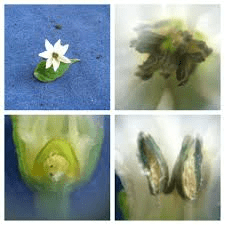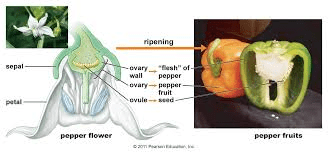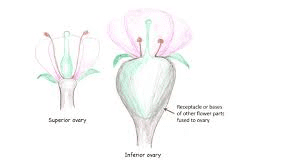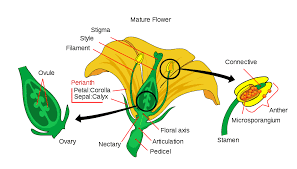The pepper ovary, scientifically known as the fruit or pod of the pepper plant, plays a crucial role in the growth, development, and culinary use of peppers.
Botanically, peppers belong to the genus Capsicum, which includes a variety of species cultivated for their fruits. The ovary of the pepper plant develops into what is commonly referred to as the pepper fruit or pepper pod. This fruit undergoes several stages of growth and ripening, resulting in a range of colors, shapes, sizes, and levels of spiciness depending on the pepper variety.
Economically, peppers are significant crops globally, contributing to both local and international markets. They are cultivated in diverse climates and regions, making them accessible to a wide range of consumers and culinary traditions. The ovary of the pepper plant, once matured and harvested, is used fresh, dried, or processed into various culinary products, including spices, sauces, and condiments.
Nutritionally, pepper ovaries are rich in vitamins, minerals, and antioxidants. They are particularly known for their high content of vitamin C, which supports immune function, skin health, and collagen production. Peppers also provide vitamin A, essential for vision health and immune function, and vitamin K, which plays a role in blood clotting and bone health. Additionally, peppers contain dietary fiber, which supports digestive health and helps regulate blood sugar levels.
Culinarily, pepper ovaries are prized for their distinct flavors, ranging from sweet to spicy, depending on the pepper variety. Sweet peppers, such as bell peppers, are often used raw in salads, sandwiches, and dips, or cooked in stir-fries, soups, and casseroles. Hot peppers, such as jalapeños, serranos, and habaneros, add heat and flavor to dishes and are used in salsas, marinades, and spicy sauces. Peppers can be roasted, grilled, stuffed, pickled, or dried to enhance their flavor and extend their culinary versatility.
In the culinary arts, peppers are also used to create spices such as paprika and chili powder, which are widely used in seasoning and flavoring various dishes. These spices are derived from dried and ground pepper ovaries, adding color, heat, and depth of flavor to cuisines around the world.
Medicinally, peppers have been studied for their potential health benefits, attributed in part to their capsaicin content. Capsaicin is a compound responsible for the heat sensation in hot peppers and is associated with anti-inflammatory and pain-relieving properties. Peppers are also rich in antioxidants, which help protect cells from damage caused by free radicals and oxidative stress, potentially reducing the risk of chronic diseases.
The pepper ovary, or fruit of the pepper plant, is a versatile and nutritionally valuable ingredient in culinary traditions worldwide. Its economic significance, culinary diversity, nutritional benefits, and potential health-promoting properties highlight its importance in global agriculture and consumer markets. Embracing the culinary and medicinal potential of pepper ovaries supports sustainable agriculture practices and promotes health and well-being through diverse and flavorful food choices.
The Economic Importance and Uses of Pepper Ovary

1. Spice Production: The ovary of pepper plants is used to produce various spices, such as black pepper, adding flavor to food.
2. Culinary Ingredient: Fresh and dried pepper ovary is widely used in cooking, enhancing the taste of dishes.
3. Medicinal Uses: Pepper ovary contains compounds that have anti-inflammatory and antioxidant properties, useful in traditional medicine.
4. Export Commodity: Pepper is a significant export commodity, contributing to the economies of many countries.
5. Preservatives: The antimicrobial properties of pepper ovary are used as natural preservatives in food.
6. Food Industry: Pepper ovary is used in the food industry to make sauces, seasonings, and marinades.
7. Cosmetic Industry: Extracts from pepper ovary are used in skincare products for their antioxidant properties.
8. Weight Management: Pepper ovary is used in dietary supplements that aid in weight management by boosting metabolism.
9. Pest Control: Capsaicin from pepper ovary is used in natural pest control products.
10. Animal Feed: By-products of pepper ovary processing can be used as additives in animal feed.
11. Biopesticides: Extracts from pepper ovary are used to develop biopesticides that protect crops.
12. Aromatherapy: Essential oils derived from pepper ovary are used in aromatherapy for their stimulating effects.
13. Pain Relief: Capsaicin from pepper ovary is used in topical creams and patches for pain relief.
14. Food Colorants: Natural colorants from pepper ovary are used in the food industry.
15. Beverage Industry: Pepper ovary is used to flavor various beverages, including cocktails and health drinks.
16. Antioxidant Source: Pepper ovary is rich in antioxidants, making it useful in health supplements.
17. Digestive Aid: Pepper ovary is used in traditional medicine to improve digestion and treat gastrointestinal issues.
18. Agricultural Industry: Pepper ovary is used in crop rotation practices to improve soil health and reduce pests.
Read Also: 7 Medicinal Health Benefits of Gynostemma pentaphyllum (Southern Ginseng)
The Products and By-products That Can Be Derived From Pepper Ovary

1. Black Pepper: Produced by drying and grinding pepper ovary, widely used as a spice.
2. White Pepper: Made by removing the outer layer of the pepper ovary and drying the seed, used as a milder spice.
3. Red Pepper: Produced by drying and grinding ripe pepper ovary, used in various culinary dishes.
4. Pepper Oil: Extracted through steam distillation, used in aromatherapy and cosmetics.
5. Pepper Extract: Made by extracting the active compounds from pepper ovary, used in supplements and medicines.
6. Capsaicin Cream: Produced from the active compound in pepper ovary, used for pain relief.
7. Pepper Sauce: Made by blending fresh or dried pepper ovary with other ingredients, used as a condiment.
8. Pepper Seasoning: A blend of ground pepper ovary and other spices, used to season food.
9. Pepper Powder: Finely ground pepper ovary, used as a spice in cooking.
10. Pepper Paste: Made by blending fresh pepper ovary, used in marinades and sauces.
11. Pepper Essential Oil: Extracted through distillation, used in aromatherapy and skincare products.
12. Pepper Vinegar: Made by infusing vinegar with pepper ovary, used as a condiment and marinade.
13. Biopesticides: Produced from extracts of pepper ovary, used in organic farming.
14. Animal Feed Additive: By-products from pepper ovary processing used as a nutritional additive in animal feed.
15. Pepper Capsules: Made from ground pepper ovary, used as a dietary supplement.
16. Pepper Flakes: Dried and crushed pepper ovary, used as a spice in cooking.
17. Pepper Tea: Made by infusing dried pepper ovary in hot water, used for its medicinal properties.
Read Also: 7 Medicinal Health Benefits of Sandalwood (Santalum album)
Frequently Asked Questions (FAQ’s) About Pepper Ovary

1. What is the pepper ovary?
The pepper ovary is the part of the pepper plant that contains the seeds, commonly used to produce spices.
2. How is black pepper made from the pepper ovary?
Black pepper is made by harvesting the green pepper ovary, fermenting it briefly, and then drying it until it turns black.
3. What are the health benefits of pepper ovary?
Pepper ovary is rich in antioxidants and has anti-inflammatory properties, beneficial for digestion and overall health.
4. Can pepper ovary be used in skincare?
Yes, extracts from pepper ovary are used in skincare products for their antioxidant and anti-inflammatory properties.
5. How is white pepper different from black pepper?
White pepper is made by removing the outer layer of the pepper ovary and drying the seed, resulting in a milder flavor compared to black pepper.
6. What is capsaicin, and how is it derived from pepper ovary?
Capsaicin is an active compound in pepper ovary that provides heat and is used in pain relief creams and pest control products.
7. Are there any side effects of consuming pepper ovary?
While generally safe, excessive consumption of pepper ovary can cause digestive discomfort in some individuals.
8. How can pepper ovary be used in cooking?
Pepper ovary can be used fresh, dried, or ground as a spice in various dishes, adding flavor and heat.
9. What are the industrial uses of pepper ovary?
Pepper ovary is used in food processing, cosmetics, pharmaceuticals, and as natural pesticides in agriculture.
10. Can pepper ovary be used in beverages?
Yes, pepper ovary is used to flavor beverages such as cocktails, health drinks, and teas.
Read Also: Waste Management Startups: The Future of Sustainable Waste Management

